belt FIAT DOBLO COMBI 2016 2.G User Guide
[x] Cancel search | Manufacturer: FIAT, Model Year: 2016, Model line: DOBLO COMBI, Model: FIAT DOBLO COMBI 2016 2.GPages: 298, PDF Size: 25.92 MB
Page 110 of 298
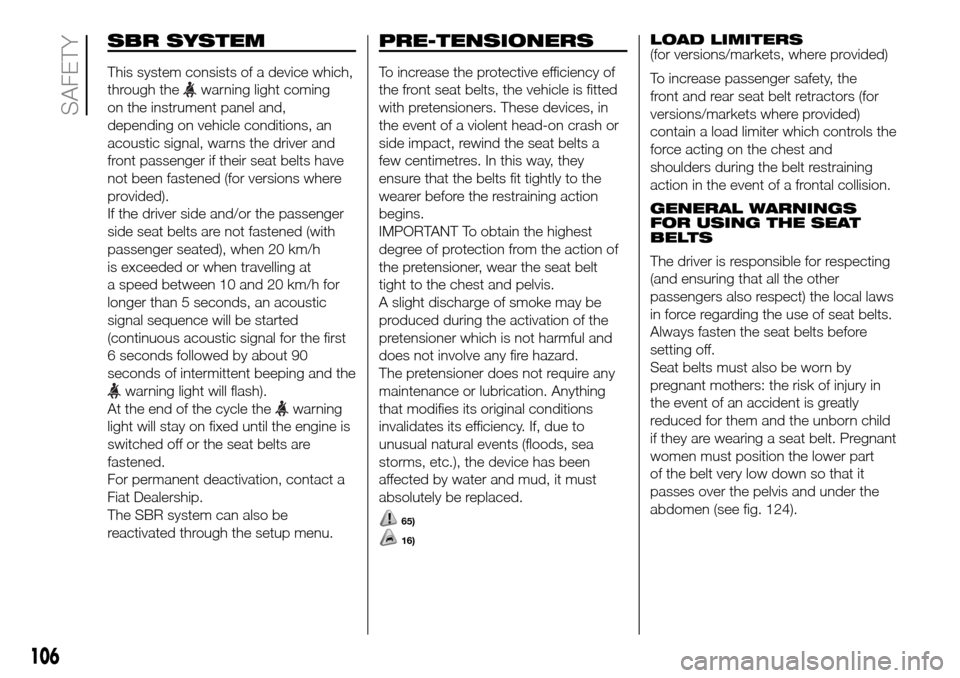
SBR SYSTEM
This system consists of a device which,
through the
warning light coming
on the instrument panel and,
depending on vehicle conditions, an
acoustic signal, warns the driver and
front passenger if their seat belts have
not been fastened (for versions where
provided).
If the driver side and/or the passenger
side seat belts are not fastened (with
passenger seated), when 20 km/h
is exceeded or when travelling at
a speed between 10 and 20 km/h for
longer than 5 seconds, an acoustic
signal sequence will be started
(continuous acoustic signal for the first
6 seconds followed by about 90
seconds of intermittent beeping and the
warning light will flash).
At the end of the cycle the
warning
light will stay on fixed until the engine is
switched off or the seat belts are
fastened.
For permanent deactivation, contact a
Fiat Dealership.
The SBR system can also be
reactivated through the setup menu.
PRE-TENSIONERS
To increase the protective efficiency of
the front seat belts, the vehicle is fitted
with pretensioners. These devices, in
the event of a violent head-on crash or
side impact, rewind the seat belts a
few centimetres. In this way, they
ensure that the belts fit tightly to the
wearer before the restraining action
begins.
IMPORTANT To obtain the highest
degree of protection from the action of
the pretensioner, wear the seat belt
tight to the chest and pelvis.
A slight discharge of smoke may be
produced during the activation of the
pretensioner which is not harmful and
does not involve any fire hazard.
The pretensioner does not require any
maintenance or lubrication. Anything
that modifies its original conditions
invalidates its efficiency. If, due to
unusual natural events (floods, sea
storms, etc.), the device has been
affected by water and mud, it must
absolutely be replaced.
65)
16)
LOAD LIMITERS
(for versions/markets, where provided)
To increase passenger safety, the
front and rear seat belt retractors (for
versions/markets where provided)
contain a load limiter which controls the
force acting on the chest and
shoulders during the belt restraining
action in the event of a frontal collision.
GENERAL WARNINGS
FOR USING THE SEAT
BELTS
The driver is responsible for respecting
(and ensuring that all the other
passengers also respect) the local laws
in force regarding the use of seat belts.
Always fasten the seat belts before
setting off.
Seat belts must also be worn by
pregnant mothers: the risk of injury in
the event of an accident is greatly
reduced for them and the unborn child
if they are wearing a seat belt. Pregnant
women must position the lower part
of the belt very low down so that it
passes over the pelvis and under the
abdomen (see fig. 124).
106
SAFETY
Page 111 of 298
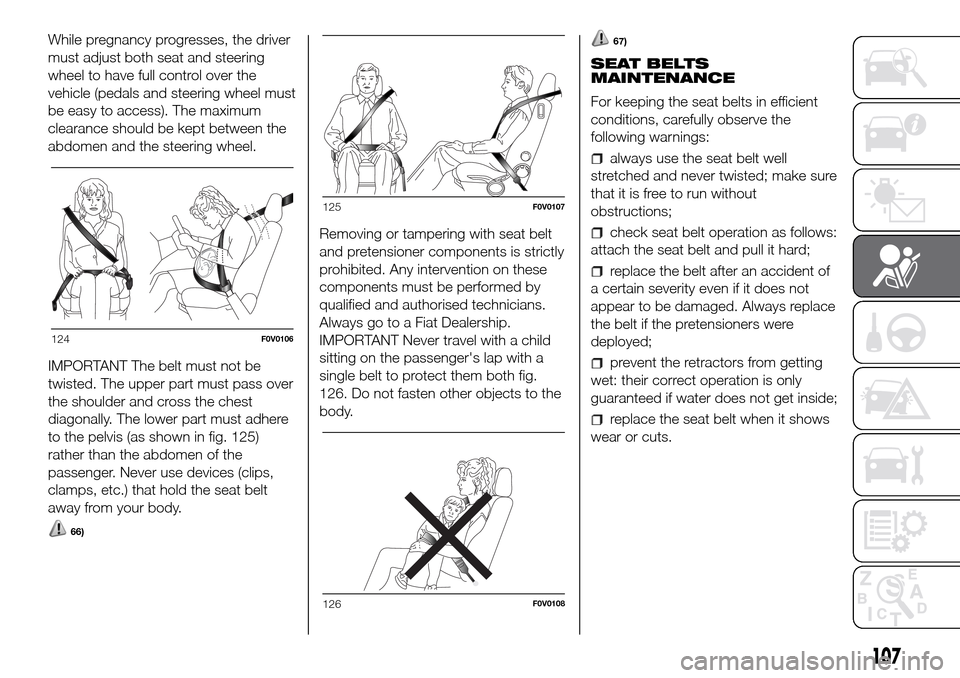
While pregnancy progresses, the driver
must adjust both seat and steering
wheel to have full control over the
vehicle (pedals and steering wheel must
be easy to access). The maximum
clearance should be kept between the
abdomen and the steering wheel.
IMPORTANT The belt must not be
twisted. The upper part must pass over
the shoulder and cross the chest
diagonally. The lower part must adhere
to the pelvis (as shown in fig. 125)
rather than the abdomen of the
passenger. Never use devices (clips,
clamps, etc.) that hold the seat belt
away from your body.
66)
Removing or tampering with seat belt
and pretensioner components is strictly
prohibited. Any intervention on these
components must be performed by
qualified and authorised technicians.
Always go to a Fiat Dealership.
IMPORTANT Never travel with a child
sitting on the passenger's lap with a
single belt to protect them both fig.
126. Do not fasten other objects to the
body.
67)
SEAT BELTS
MAINTENANCE
For keeping the seat belts in efficient
conditions, carefully observe the
following warnings:
always use the seat belt well
stretched and never twisted; make sure
that it is free to run without
obstructions;
check seat belt operation as follows:
attach the seat belt and pull it hard;
replace the belt after an accident of
a certain severity even if it does not
appear to be damaged. Always replace
the belt if the pretensioners were
deployed;
prevent the retractors from getting
wet: their correct operation is only
guaranteed if water does not get inside;
replace the seat belt when it shows
wear or cuts.
124F0V0106
125F0V0107
126F0V0108
107
Page 112 of 298

WARNING
65)The pretensioner may be used only
once. After it is triggered, have it replaced
at a Fiat Dealership.
66)For maximum safety, keep the backrest
upright, lean back into it and make sure
the seat belt fits closely across your chest
and pelvis. Always fasten the seat belts
on both the front and the rear seats!
Travelling without wearing seat belts will
increase the risk of serious injury and even
death in the event of an accident.
67)If the belt has been sharply pulled, for
example as the result of an accident, the
seat belt, together with the anchoring
devices, the anchoring device fixing screws
and the pretensioner must be completely
replaced. Even if the belt does not present
any exterior signs of wear or damage, it
may have lost its restraining properties.
WARNING
16)Operations which lead to knocks,
vibrations or localised heating (over 100°C
for a maximum of 6 hours) in the area
around the pretensioners may cause
damage or trigger them. These devices are
not affected by vibrations caused by
irregularities of the road surface or low
obstacles such as kerbs, etc. Contact a
Fiat Dealership for any assistance.
CARRYING
CHILDREN SAFELY
For optimal protection in the event of an
impact, all passengers must be seated
and wearing adequate restraint
systems.
This is even more important for
children.
This prescription is compulsory in all EU
countries according to EC Directive
2003/20/EC.
Compared with an adult, a child's head
is larger and heavier in proportion to
their body and the child's muscular and
bone structures are not fully developed.
Therefore, correct restraint systems
other than adult seat belts are
necessary to reduce as much as
possible the risk of injuries in the event
of an accident, braking or a sudden
manoeuvre.
Children must be seated safely and
comfortably.
Depending on the characteristics of the
child restraint systems used, you are
advised to keep children in rear-facing
child restraint systems for as long as
possible (at least until 3-4 years old),
since this is the most protected position
in the event of an impact.It is recommended to always choose
the restraint system most suitable
for the child; for this reason always refer
to the Owner Handbook provided with
the child restraint system, to be sure
that it is of the right type for the children
it is intended for.
When over 1.50 m in height, from the
point of view of restraint systems,
children are considered as adults and
wear seat belts normally.
In Europe child restraint systems are
classified, among other criteria, into five
weight groups:
Group Weight groups
Group 0up to 10 kg in
weight
Group 0+up to 13 kg in
weight
Group 1 9 - 18 kg
Group 2 15 - 25 kg
Group 3 22 - 36 kg
All restraint devices must bear the
certification data, together with the
control mark, on a label solidly fixed to
the child restraint system which must
never be removed.
Lineaccessori Fiat offers child restraint
systems for each weight group. These
devices are recommended having been
specifically designed for Fiat vehicles.
108
SAFETY
Page 113 of 298
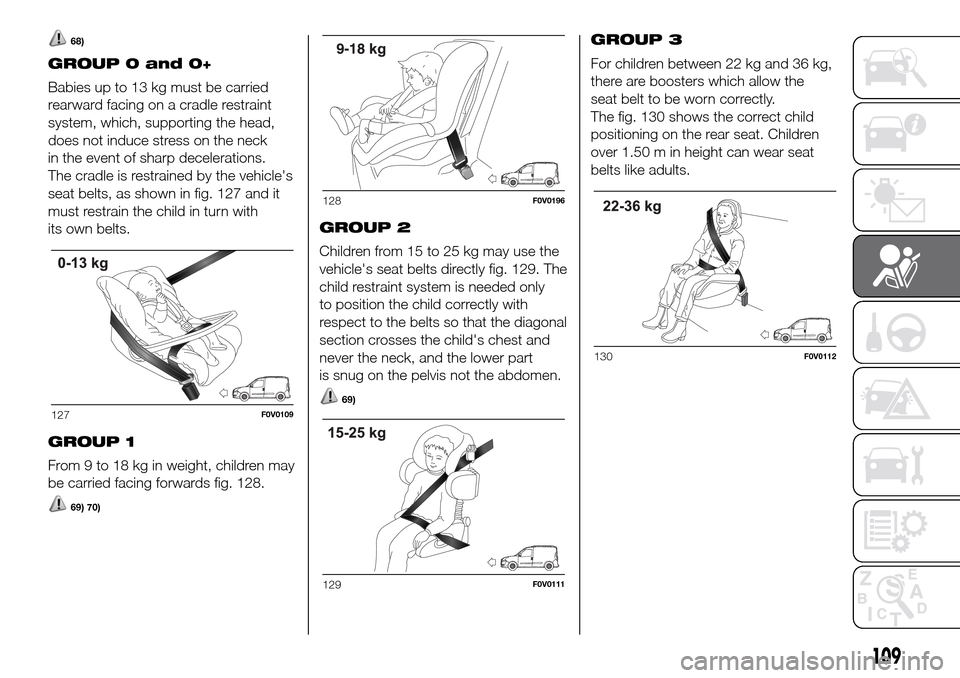
68)
GROUP 0 and 0+
Babies up to 13 kg must be carried
rearward facing on a cradle restraint
system, which, supporting the head,
does not induce stress on the neck
in the event of sharp decelerations.
The cradle is restrained by the vehicle's
seat belts, as shown in fig. 127 and it
must restrain the child in turn with
its own belts.
GROUP 1
From 9 to 18 kg in weight, children may
be carried facing forwards fig. 128.
69) 70)
GROUP 2
Children from 15 to 25 kg may use the
vehicle's seat belts directly fig. 129. The
child restraint system is needed only
to position the child correctly with
respect to the belts so that the diagonal
section crosses the child's chest and
never the neck, and the lower part
is snug on the pelvis not the abdomen.
69)
GROUP 3
For children between 22 kg and 36 kg,
there are boosters which allow the
seat belt to be worn correctly.
The fig. 130 shows the correct child
positioning on the rear seat. Children
over 1.50 m in height can wear seat
belts like adults.
127F0V0109
128F0V0196
129F0V0111
130F0V0112
109
Page 115 of 298

WARNING
68)SERIOUS DANGER: When an active passenger airbag is fitted, DO NOT install rear facing child restraint systems on the front seat.
Deployment of the airbag in an accident could cause fatal injuries to the child regardless of the severity of the impact. It is advisable to always
carry children in a child restraint system on the rear seat, which is the most protected position in the event of a collision. Should it be
necessary to carry a child on the passenger side front seat in a rear-facing child restraint system, the passenger side front airbag and side
bag (for versions/markets, where provided) must be deactivated through the Setup menu. Deactivation should be verified by checking that
the
warning light above the front courtesy light is switched on. Move the passenger's seat as far back as possible to avoid contact
between the child seat and the dashboard.
69)The figures are only examples for fitting purposes. Fit the child restraint system according to the instructions, which must be included.
70)Child seats with Isofix attachments are available for a safe anchoring to the seat without using the car seat belts. Follow the assembly
instructions carefully.
111
Page 116 of 298
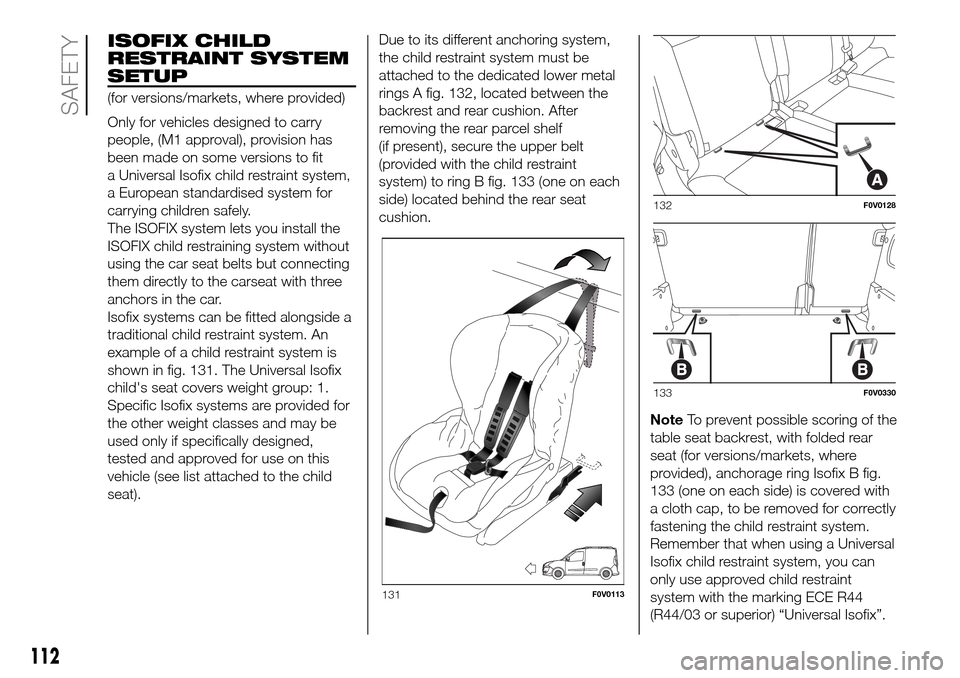
ISOFIX CHILD
RESTRAINT SYSTEM
SETUP
(for versions/markets, where provided)
Only for vehicles designed to carry
people, (M1 approval), provision has
been made on some versions to fit
a Universal Isofix child restraint system,
a European standardised system for
carrying children safely.
The ISOFIX system lets you install the
ISOFIX child restraining system without
using the car seat belts but connecting
them directly to the carseat with three
anchors in the car.
Isofix systems can be fitted alongside a
traditional child restraint system. An
example of a child restraint system is
shown in fig. 131. The Universal Isofix
child's seat covers weight group: 1.
Specific Isofix systems are provided for
the other weight classes and may be
used only if specifically designed,
tested and approved for use on this
vehicle (see list attached to the child
seat).Due to its different anchoring system,
the child restraint system must be
attached to the dedicated lower metal
rings A fig. 132, located between the
backrest and rear cushion. After
removing the rear parcel shelf
(if present), secure the upper belt
(provided with the child restraint
system) to ring B fig. 133 (one on each
side) located behind the rear seat
cushion.
NoteTo prevent possible scoring of the
table seat backrest, with folded rear
seat (for versions/markets, where
provided), anchorage ring Isofix B fig.
133 (one on each side) is covered with
a cloth cap, to be removed for correctly
fastening the child restraint system.
Remember that when using a Universal
Isofix child restraint system, you can
only use approved child restraint
system with the marking ECE R44
(R44/03 or superior) “Universal Isofix”.
131F0V0113
132F0V0128
133F0V0330
112
SAFETY
Page 119 of 298
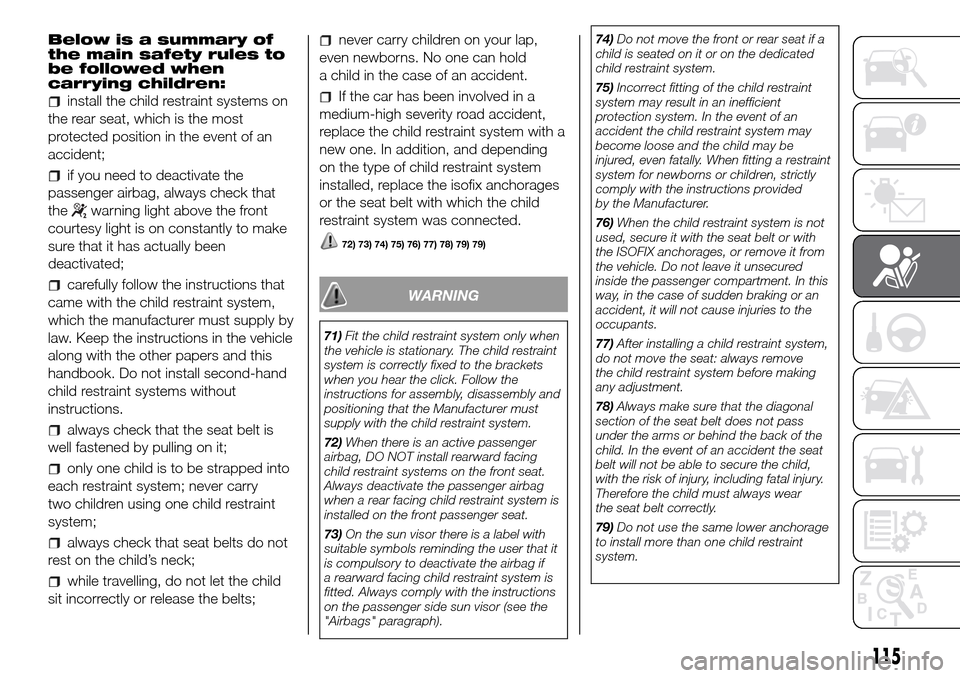
Below is a summary of
the main safety rules to
be followed when
carrying children:
install the child restraint systems on
the rear seat, which is the most
protected position in the event of an
accident;
if you need to deactivate the
passenger airbag, always check that
the
warning light above the front
courtesy light is on constantly to make
sure that it has actually been
deactivated;
carefully follow the instructions that
came with the child restraint system,
which the manufacturer must supply by
law. Keep the instructions in the vehicle
along with the other papers and this
handbook. Do not install second-hand
child restraint systems without
instructions.
always check that the seat belt is
well fastened by pulling on it;
only one child is to be strapped into
each restraint system; never carry
two children using one child restraint
system;
always check that seat belts do not
rest on the child’s neck;
while travelling, do not let the child
sit incorrectly or release the belts;
never carry children on your lap,
even newborns. No one can hold
a child in the case of an accident.
If the car has been involved in a
medium-high severity road accident,
replace the child restraint system with a
new one. In addition, and depending
on the type of child restraint system
installed, replace the isofix anchorages
or the seat belt with which the child
restraint system was connected.
72) 73) 74) 75) 76) 77) 78) 79) 79)
WARNING
71)Fit the child restraint system only when
the vehicle is stationary. The child restraint
system is correctly fixed to the brackets
when you hear the click. Follow the
instructions for assembly, disassembly and
positioning that the Manufacturer must
supply with the child restraint system.
72)When there is an active passenger
airbag, DO NOT install rearward facing
child restraint systems on the front seat.
Always deactivate the passenger airbag
when a rear facing child restraint system is
installed on the front passenger seat.
73)On the sun visor there is a label with
suitable symbols reminding the user that it
is compulsory to deactivate the airbag if
a rearward facing child restraint system is
fitted. Always comply with the instructions
on the passenger side sun visor (see the
"Airbags" paragraph).74)Do not move the front or rear seat if a
child is seated on it or on the dedicated
child restraint system.
75)Incorrect fitting of the child restraint
system may result in an inefficient
protection system. In the event of an
accident the child restraint system may
become loose and the child may be
injured, even fatally. When fitting a restraint
system for newborns or children, strictly
comply with the instructions provided
by the Manufacturer.
76)When the child restraint system is not
used, secure it with the seat belt or with
the ISOFIX anchorages, or remove it from
the vehicle. Do not leave it unsecured
inside the passenger compartment. In this
way, in the case of sudden braking or an
accident, it will not cause injuries to the
occupants.
77)After installing a child restraint system,
do not move the seat: always remove
the child restraint system before making
any adjustment.
78)Always make sure that the diagonal
section of the seat belt does not pass
under the arms or behind the back of the
child. In the event of an accident the seat
belt will not be able to secure the child,
with the risk of injury, including fatal injury.
Therefore the child must always wear
the seat belt correctly.
79)Do not use the same lower anchorage
to install more than one child restraint
system.
115
Page 120 of 298
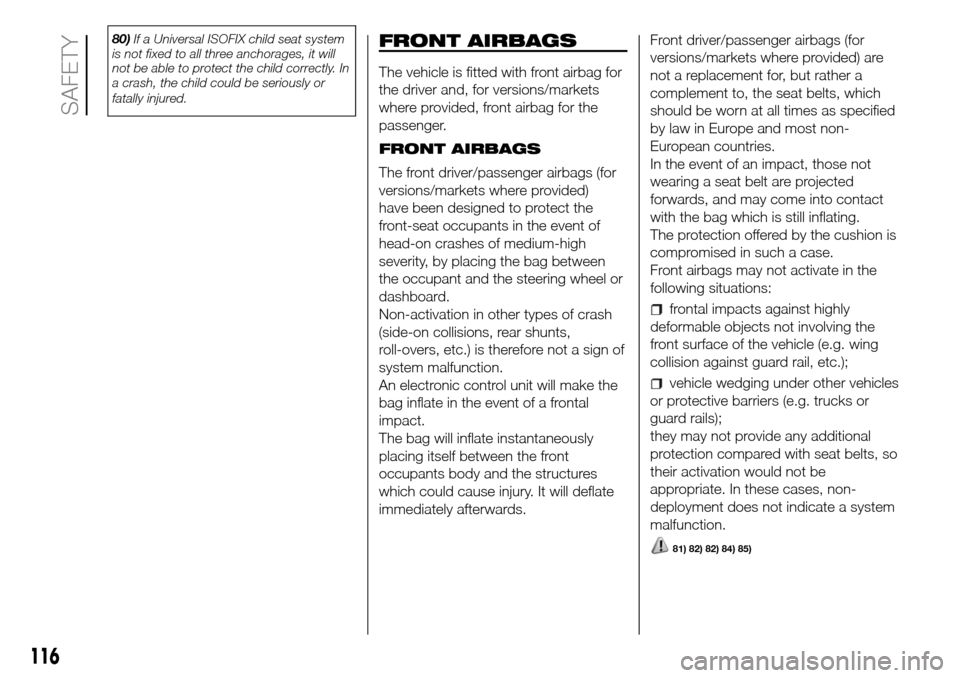
80)If a Universal ISOFIX child seat system
is not fixed to all three anchorages, it will
not be able to protect the child correctly. In
a crash, the child could be seriously or
fatally injured.FRONT AIRBAGS
The vehicle is fitted with front airbag for
the driver and, for versions/markets
where provided, front airbag for the
passenger.
FRONT AIRBAGS
The front driver/passenger airbags (for
versions/markets where provided)
have been designed to protect the
front-seat occupants in the event of
head-on crashes of medium-high
severity, by placing the bag between
the occupant and the steering wheel or
dashboard.
Non-activation in other types of crash
(side-on collisions, rear shunts,
roll-overs, etc.) is therefore not a sign of
system malfunction.
An electronic control unit will make the
bag inflate in the event of a frontal
impact.
The bag will inflate instantaneously
placing itself between the front
occupants body and the structures
which could cause injury. It will deflate
immediately afterwards.Front driver/passenger airbags (for
versions/markets where provided) are
not a replacement for, but rather a
complement to, the seat belts, which
should be worn at all times as specified
by law in Europe and most non-
European countries.
In the event of an impact, those not
wearing a seat belt are projected
forwards, and may come into contact
with the bag which is still inflating.
The protection offered by the cushion is
compromised in such a case.
Front airbags may not activate in the
following situations:
frontal impacts against highly
deformable objects not involving the
front surface of the vehicle (e.g. wing
collision against guard rail, etc.);
vehicle wedging under other vehicles
or protective barriers (e.g. trucks or
guard rails);
they may not provide any additional
protection compared with seat belts, so
their activation would not be
appropriate. In these cases, non-
deployment does not indicate a system
malfunction.
81) 82) 82) 84) 85)
116
SAFETY
Page 121 of 298

The driver's and passenger's front
airbags have been designed and
calibrated to protect front seat
occupants wearing seat belts.
At their maximum inflation, their volume
fills most of the space between the
steering wheel and the driver and
between the dashboard and the
passenger.
The airbags are not deployed in the
event of minor frontal impacts (for
which the restraining action of the seat
belts is sufficient). It is therefore always
necessary to wear seat belts.
FRONT AIRBAG DRIVER'S
SIDE
This consists of an instantly inflating
bag contained in a special
compartment in the centre of the
steering wheel fig. 134.PASSENGER SIDE FRONT
AIRBAG
(for versions/markets, where provided)
This consists of an instantly inflating
bag contained in a special recess in the
dashboard. This bag has a larger
volume than that of the driver fig. 135.FRONT PASSENGER SIDE
AIRBAG AND CHILD
RESTRAINT SYSTEMS
86)Rearward facing child restraint systems
must NEVER be fitted on the front
seat with an active passenger side
airbag since in the event of an impact
the airbag activation may cause fatal
injuries to the transported child.
ALWAYS comply with the instructions
on the label fig. 136 stuck on the
passenger side sun visor.
134F0V0511
135F0V0512
136F0T0950
117
Page 124 of 298

WARNING
81)Do not apply stickers or other objects to the steering wheel, the dashboard in the passenger side airbag area and the seats. Never put
objects (e.g. mobile phones) on the passenger side of the dashboard since they could interfere with correct inflation of the passenger airbag
and also cause serious injury to the passengers.
82)Always drive with your hands on the rim of the steering wheel so that the airbag can inflate freely if required. Do not drive with your body
bent forward. Keep your back straight against the backrest.
83)The airbag deployment threshold is higher than that of the pretensioners. For collisions in the range between the two thresholds, it is
normal for only the pretensioners to be activated.
84)The airbag does not replace seat belts but increases their efficiency. Because front airbags are not deployed for low-speed crashes, side
collisions, rear-end shunts or rollovers, occupants are protected, in addition to any side bags, only by their seat belts, which must therefore
always be fastened.
85)In some versions, in the event of a failure of the
LED (located on the front courtesy light), thewarning light on the instrument panel
turns on and the passenger side airbags are deactivated.
86)When there is an active passenger airbag, DO NOT install rearward facing child restraint systems on the front seat. Deployment of the
airbag in an accident could cause fatal injuries to the child regardless of the severity of the impact. Therefore, always deactivate the
passenger side airbag when a rearward facing child restraint system is installed on the front passenger seat. The front passenger seat must
also be positioned back as far as possible in order to prevent the child restraint system from coming into contact with the dashboard.
Immediately reactivate the passenger airbag as soon as the child restraint system has been removed.
120
SAFETY